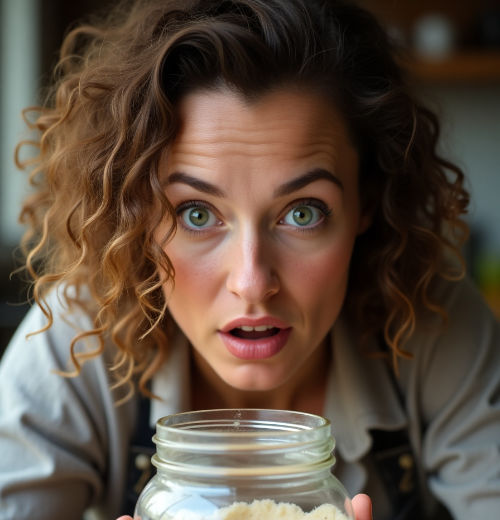Mold on Sourdough Starter: A Common Challenge and How to Prevent It

If you’ve been nurturing a sourdough starter for any length of time, you’ve probably had a moment of horror when you lifted the lid and saw something fuzzy staring back at you. Mold! It’s frustrating, but you’re not alone. Every baker who keeps a starter long-term will deal with mold at some point. The good news? It’s preventable. Let’s talk about why it happens and how we can keep our starters strong, healthy, and mold-free.
Why Does Mold Grow on Sourdough Starter?
Your starter is a living culture, a mix of wild yeast and bacteria that thrives when given the right conditions. But mold—unwanted invaders—can sneak in when things get off balance. Here’s why it happens:
1. Contamination – Our kitchens are full of airborne mold spores, and if they land in a weak or neglected starter, they can take over. Dirty jars, hands, or utensils don’t help either.
2. Infrequent Feedings – A neglected starter loses its acidity over time, making it more welcoming to mold. Regular feedings keep it strong.
3. Too Much Moisture – A very liquid starter or condensation inside the jar creates the damp conditions mold loves.
4. Low Acidity – A healthy starter has a low pH (acidic), which naturally prevents mold. If it’s underfed or weak, it can lose this protective acidity.
5. Warm, Humid Storage – Mold thrives in warmth and humidity. If your kitchen is on the warmer side, your starter might need more care.
6. Whole-Grain Flours – While amazing for flavor, whole grains carry more natural bacteria and spores. They need regular refreshment to prevent spoilage.
7. Improper Lid Choice – A cloth lid can allow airborne mold spores to land directly on your starter.
8. Plastic Containers Harbor Mold – Plastic containers may seem convenient, but over time, they develop micro-cracks and scratches that are impossible to fully clean. These tiny imperfections trap moisture and harbor mold spores, increasing the risk of contamination. Glass jars are a better choice, as they don’t degrade or absorb residue from previous feedings. If you must use plastic, replace it frequently and sanitize it thoroughly between uses.
How to Prevent Mold on Your Starter
Now for the good part—how to keep your starter mold-free and thriving!
✅ Feed It Regularly – If you keep your starter on the counter, daily feedings maintain its acidity. If refrigerated, feed it at least once a week. A strong starter is a resilient starter!
✅ Keep Things Clean – Wash your jar between feedings (especially if you see residue buildup), use clean utensils, and keep your hands clean when handling.
✅ Store It Wisely – If your kitchen is hot and humid, mold can be more aggressive. A cooler, drier space is ideal.
✅ Avoid Excess Moisture – If storing in a jar with a lid, avoid condensation buildup.
✅ Choose the Right Flour – Whole-grain flours are nutritious but can introduce extra bacteria. If you’re battling mold, try feeding with unbleached white flour for a few feedings to stabilize the starter.
✅ Do NOT Use Chlorinated Water – Unlike mold, chlorine kills the good bacteria in your starter. Use filtered or dechlorinated water to keep it happy and active.
✅ Use the Right Lid – While some bakers prefer a cloth cover, we recommend using a loose mason jar lid or one of our silicone pressure-relieving lids. This allows gas to escape while keeping airborne mold spores out—something a cloth lid can’t always do.
✅ Use a glass container – Glass doesn’t suffer from micro-cracks like plastic does and gives nowhere for the mold to hide.
When to Say Goodbye
If you see mold, don’t just scrape it off. Mold spores spread invisibly, and eating moldy sourdough isn’t worth the risk. If mold appears, it’s best to discard the starter and begin fresh with a small saved portion (if mold-free) or a brand-new batch.
Addendum: The Black Death Starter (Dark Rye) and Overhydration
If you’ve ever worked with a dark rye starter (sometimes called Black Death due to its rich color), you may have noticed it behaves differently from other starters. Rye flour absorbs and holds water differently than white or whole wheat flours, and one of the biggest mistakes bakers make is trying to hydrate it to match the consistency of other starters.
A properly hydrated dark rye starter should look almost dry and crumbly, not smooth and sticky like a white flour starter. If you add too much water, it becomes too wet, making it more prone to mold. Overhydration creates an environment where mold can take hold before the acidity develops enough to prevent it. If you’re seeing mold on your rye starter, try reducing hydration and keeping it firmer—this will help keep it strong and resilient.
Mold happens to the best of us, but with a little care, we can keep our starters thriving. Keep feeding, keep baking, and happy sourdough adventures!
— Nottingham Farm



